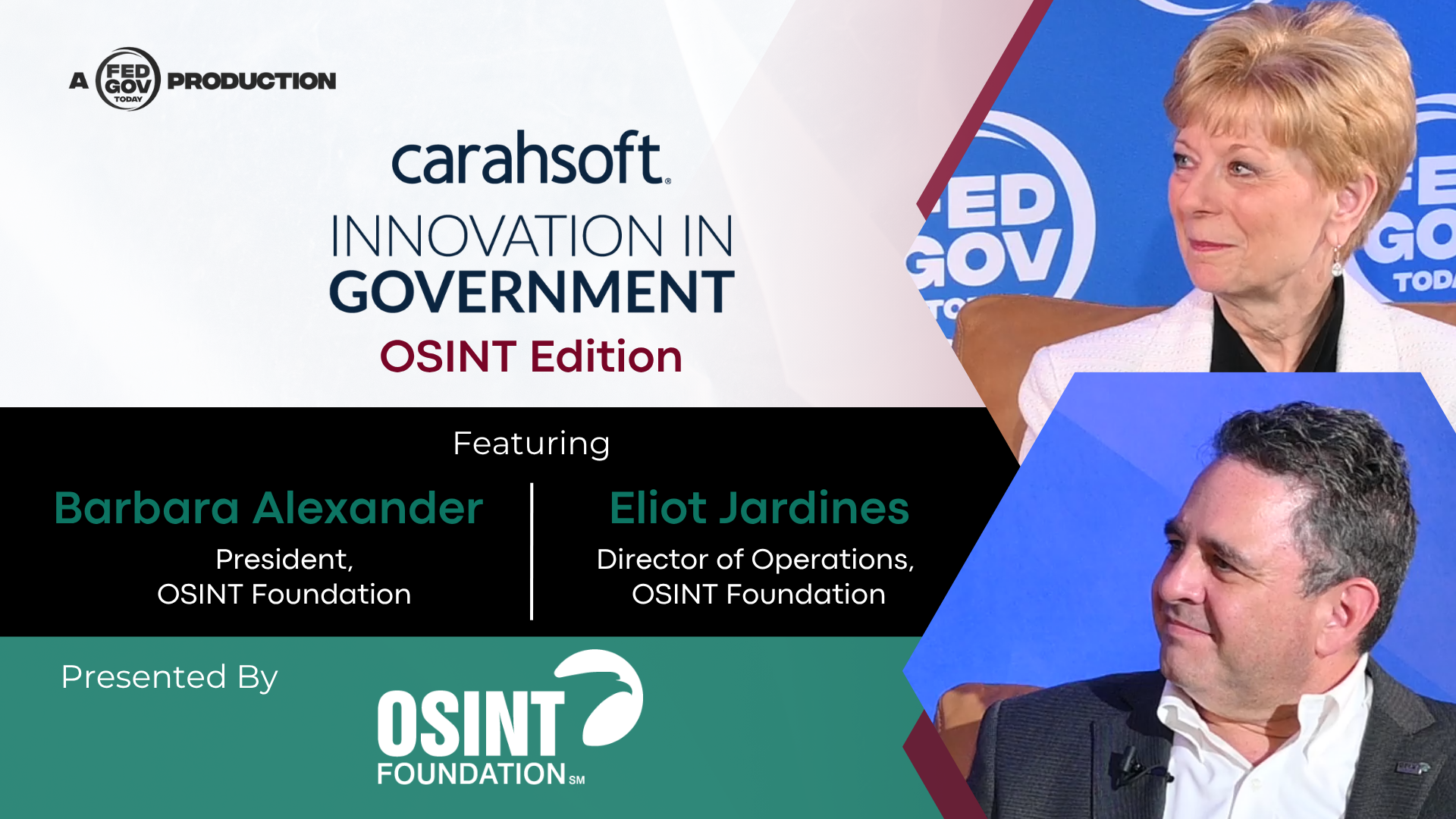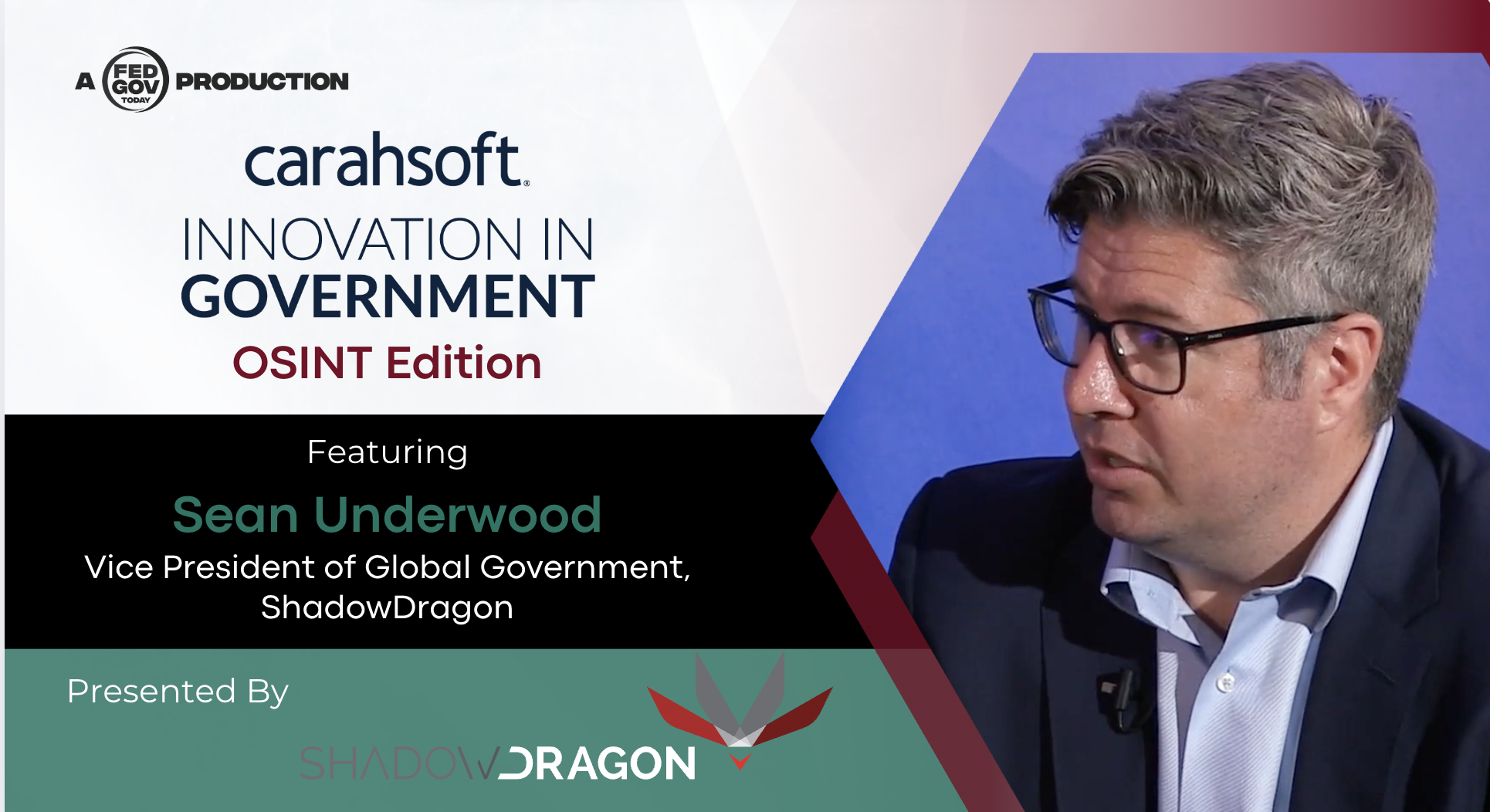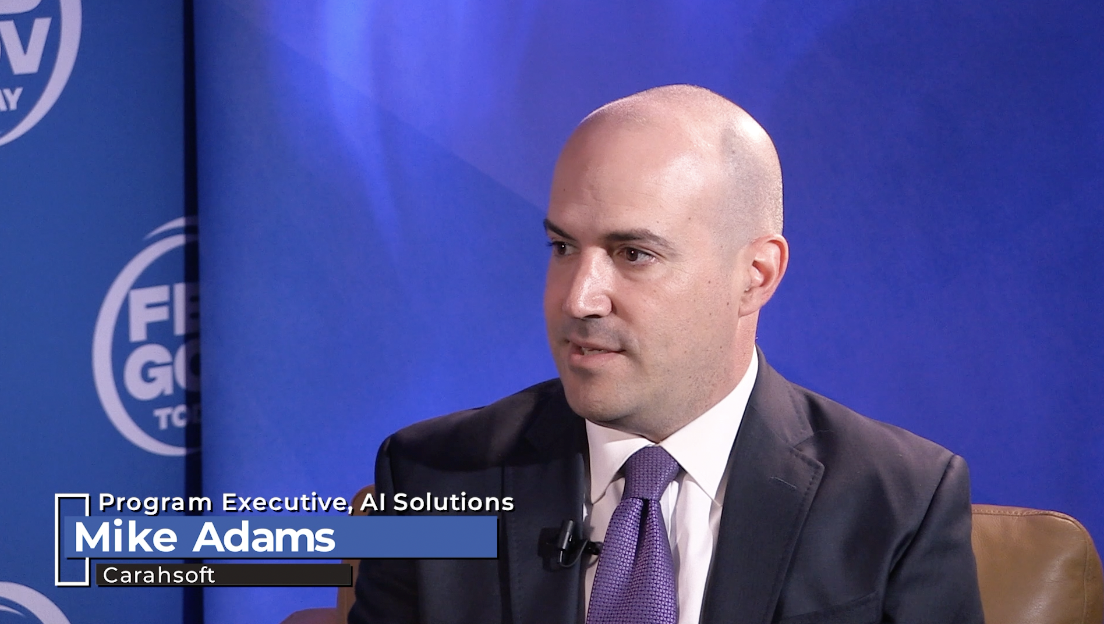Presented by Carahsoft
Open Source Intelligence (OSINT) has evolved from a niche collection method into a foundational pillar of national security, law enforcement, and federal decision-making. In this special edition of Innovation in Government, recorded at the OSINT Tech Expo, leaders from government and industry explore how OSINT is being operationalized at scale — and what comes next. From data reliability and AI integration to policy, training, and professionalization, this program brings you the voices of those shaping the discipline’s future.
Building Community and Professionalism in OSINT
Barbara Alexander, President, and Eliot Jardines, Director of Operations, OSINT Foundation
 Barbara Alexander and Eliot Jardines of the OSINT Foundation are on a mission to transform open source intelligence from an often-dismissed practice to a professionalized, structured, and essential intelligence discipline. Their work focuses on elevating standards, building community, and creating a pipeline of career development for those working in OSINT.
Barbara Alexander and Eliot Jardines of the OSINT Foundation are on a mission to transform open source intelligence from an often-dismissed practice to a professionalized, structured, and essential intelligence discipline. Their work focuses on elevating standards, building community, and creating a pipeline of career development for those working in OSINT.
Alexander recounts how the Foundation emerged out of frustration during the pandemic, as webinars and commentary on OSINT were often led by individuals with no real experience in the discipline. She and Jardines wanted to give practitioners a platform for peer recognition, skill development, and networking. The result is a growing national organization with its own certification initiatives and an annual event that has doubled in size each year.
Jardines notes that today’s OSINT practitioners must be fluent in data science, AI, and emerging technologies. The challenge is not just building tools but teaching analysts how to use them effectively. They advocate for more cross-training between technologists and intelligence professionals, ensuring both understand each other’s needs and constraints.
Importantly, the Foundation is also working to educate senior leadership in government. While mid-level professionals often understand OSINT’s value, buy-in at the top remains inconsistent. Events and awards hosted by the Foundation aim to bridge that gap and promote institutional support.
Key Takeaways:
-
OSINT is evolving into a professional discipline that demands structure and certification.
-
Cross-training between analysts and technologists is essential to maximize tool utility.
-
Senior government leaders need better education on OSINT’s capabilities and value.
Accelerating Actionable Insight in Government Data Ecosystems
Michael Shrader, Vice President, Carahsoft
 Michael Shrader of Carahsoft emphasizes the growing demand across federal agencies for OSINT that is not just accessible, but meaningful. Agencies are no longer satisfied with raw data; they need insights that are usable, timely, and integrated with existing mission workflows. Shrader describes how modern AI-powered collection and analytics tools have drastically improved the ability to convert public and commercial data into usable intelligence.
Michael Shrader of Carahsoft emphasizes the growing demand across federal agencies for OSINT that is not just accessible, but meaningful. Agencies are no longer satisfied with raw data; they need insights that are usable, timely, and integrated with existing mission workflows. Shrader describes how modern AI-powered collection and analytics tools have drastically improved the ability to convert public and commercial data into usable intelligence.
Shrader outlines a broad ecosystem of technology that supports this acceleration—from data cleansing and cataloging to infrastructure and compute layers. But he also acknowledges the risk: a noisy marketplace filled with tools and providers claiming capabilities they may not fully deliver. His call to action is clear: agencies must invest in education to understand which tools best fit their mission, and vendors must be transparent about their real capabilities.
Perhaps most critically, Shrader discusses the concept of aligning the right data product with the right problem set. A one-size-fits-all approach does not work in OSINT. Whether the mission is supply chain visibility, human intelligence, or cybersecurity, the tools and data must be mission-fit and operationally validated.
Key Takeaways:
-
Government agencies need curated, mission-ready OSINT—not just raw data dumps.
-
Market education is essential to match agencies with the right tools and providers.
-
Actionable OSINT relies on a full ecosystem of data prep, analytics, and infrastructure.
Operationalizing OSINT Across the Army and Defense Community
Greg Zellmer, Director, Army OSINT Office, U.S. Army
 Greg Zellmer, Director of the Army OSINT Office, brings a frontline perspective on how the Department of Defense is using OSINT not as a supplement, but as a central source of situational awareness. Zellmer explains that publicly available information is often the most immediate and relevant intelligence available to commanders in time-sensitive environments.
Greg Zellmer, Director of the Army OSINT Office, brings a frontline perspective on how the Department of Defense is using OSINT not as a supplement, but as a central source of situational awareness. Zellmer explains that publicly available information is often the most immediate and relevant intelligence available to commanders in time-sensitive environments.
To support that need, the Army has invested in professionalizing its OSINT force — from tradecraft and training to standardized tactics, techniques, and procedures. Zellmer highlights how automation and artificial intelligence are now indispensable for filtering vast volumes of data so that analysts can focus their cognitive energy on interpretation and decision support.
He acknowledges the enduring tension between speed and accuracy, a balance every intelligence professional must manage. The Army’s approach is to train for both — ensuring that analysts can move quickly without sacrificing the credibility or relevance of their assessments. Zellmer also notes a cultural shift in how OSINT is perceived within the broader intelligence community. Once viewed as less rigorous than classified sources, OSINT is now recognized for the value it brings when professionally collected and analyzed.
Key Takeaways:
-
OSINT is a core intelligence discipline for the Army, driving real-time operational decisions.
-
Professionalization, training, and tradecraft standards are central to its effective use.
-
Automation and AI help analysts manage scale while maintaining analytic quality.
Defining OSINT’s Boundaries and Expanding Its Mission
Sean Underwood, Vice President of Global Government, ShadowDragon
 Sean Underwood of ShadowDragon provides a nuanced look at the divergence within the OSINT world between publicly available information (PAI) and commercially available information (CAI). While both are critical to the intelligence cycle, the rules governing their use differ significantly based on mission type and legal authority. Underwood stresses that understanding this distinction is essential for effective and ethical intelligence operations.
Sean Underwood of ShadowDragon provides a nuanced look at the divergence within the OSINT world between publicly available information (PAI) and commercially available information (CAI). While both are critical to the intelligence cycle, the rules governing their use differ significantly based on mission type and legal authority. Underwood stresses that understanding this distinction is essential for effective and ethical intelligence operations.
He also addresses the rapid technological evolution in the field, especially with the growing role of automation and AI. While powerful, these tools introduce risks—such as oversimplified interfaces that can obscure the complexity behind results. Underwood warns that simplifying the OSINT process too far can create false confidence. A Google-style interface might make tools accessible, but it also demands responsible use and deep mission understanding.
Another key point Underwood raises is the growing need for training and enablement. As OSINT moves into new parts of government—well beyond traditional defense and law enforcement—there is a learning curve. Agencies must invest not only in tools but in the people using them. The future of OSINT lies in embedding capability across missions, ensuring personnel understand how to generate, evaluate, and act on open source information in their operational context.
Key Takeaways:
-
-
PAI and CAI have distinct rules and risks; OSINT users must understand the difference.
-
Over-simplifying tools can mask complexity and compromise analytical rigor.
-
OSINT success depends on training and human judgment as much as technology.
-
OSINT’s Legal, Ethical, and Evidentiary Frontier
Andrew "Swede" Borene, Executive Director, Flashpoint
 Andrew Borene of Flashpoint discusses the growing challenge of legal compliance and ethical clarity in the OSINT space, especially as more agencies incorporate commercially available information into their operations. He stresses that transparency, traceability, and evidentiary integrity are no longer optional—they are mandatory.
Andrew Borene of Flashpoint discusses the growing challenge of legal compliance and ethical clarity in the OSINT space, especially as more agencies incorporate commercially available information into their operations. He stresses that transparency, traceability, and evidentiary integrity are no longer optional—they are mandatory.
Borene points to the growing divide between raw data collectors and vetted OSINT providers. Agencies can no longer afford to treat all commercial data as equal. Some data may be scraped and aggregated indiscriminately, while others are collected with precision and accountability. Government customers must learn to ask: how was this collected? Can we audit it? Does it meet legal thresholds, especially if it’s used for law enforcement or policy decisions?
He draws a powerful comparison to the commercialization of satellite imagery — once considered highly classified, now a routine and valuable tool. OSINT is following a similar trajectory, but with more privacy and civil liberties implications. To stay ahead, agencies must require vendors to “show their math”—providing evidence chains, compliance transparency, and technical demonstrations of how data is acquired and verified.
Borene believes OSINT's future lies in enabling empowered users. Agencies shouldn't depend entirely on vendors. They should be able to task collections, run analytics, and interpret insights themselves—with vendors acting as enablers, not gatekeepers.
Key Takeaways:
-
-
OSINT used for operational or legal decisions must meet evidentiary standards.
-
Agencies must demand transparency in data sourcing, methodology, and validation.
-
The future of OSINT is customer empowerment, not vendor dependence.
-
Setting the Standard: Building Trust and Speed into Vulnerability Intelligence
Eric Hoffman, Sales Director for Public Sector, VulnCheck
 Eric Hoffman of VulnCheck addresses a fundamental challenge in OSINT today: volume is not value. Hoffman explains that government mission partners aren’t asking for more data — they’re demanding better data. His focus is on delivering structured, timely, and reliable intelligence, particularly around vulnerabilities. For OSINT to be useful, it must be actionable and supported with context and traceability.
Eric Hoffman of VulnCheck addresses a fundamental challenge in OSINT today: volume is not value. Hoffman explains that government mission partners aren’t asking for more data — they’re demanding better data. His focus is on delivering structured, timely, and reliable intelligence, particularly around vulnerabilities. For OSINT to be useful, it must be actionable and supported with context and traceability.
Hoffman notes that the speed at which OSINT providers can structure and disseminate data is critical. Government agencies need data that arrives in time to affect operations — not after decisions have already been made. Smaller, specialized firms like VulnCheck are filling gaps left by slower-moving legacy organizations, offering near real-time intelligence that allows analysts to stay inside the adversary’s decision-making loop.
He also emphasizes the importance of providence — providing backup and transparent sourcing — in a world where “black box” analytics are no longer acceptable. For OSINT to be used confidently by federal agencies, it must meet evidentiary standards and stand up to scrutiny. As Hoffman puts it, it’s not just about showing the “what,” but explaining the “why” behind every piece of data.
Key Takeaways:
-
OSINT must be timely, actionable, and structured to support real-world decision-making.
-
Reliable data sourcing and transparency are essential to earn trust in intelligence outputs.
-
Speed and accuracy must coexist to keep government agencies ahead of cyber and operational threats.
Balancing Urgency and Accuracy in OSINT-Driven Decisions
Kristen Hajduk, Vice President of Business Development and Capture, Seerist
 Kristen Hajduk of Seerist emphasizes a principle at the heart of effective OSINT: speed is meaningless without clarity. In today’s intelligence environment, agencies are overwhelmed with data but often lack the necessary context to use that information decisively. Hajduk argues that OSINT must evolve from reactive collection to proactive foresight, where agencies can anticipate events rather than simply respond to them.
Kristen Hajduk of Seerist emphasizes a principle at the heart of effective OSINT: speed is meaningless without clarity. In today’s intelligence environment, agencies are overwhelmed with data but often lack the necessary context to use that information decisively. Hajduk argues that OSINT must evolve from reactive collection to proactive foresight, where agencies can anticipate events rather than simply respond to them.
Seerist addresses this need through a unique combination of artificial intelligence and human analysis. Their platform uses forecasting models to assess long-term indicators of instability—economic, political, environmental—and flags regions trending toward volatility. Analysts then refine and interpret those trends, improving both the accuracy of the platform and the quality of insight for end users. Hajduk calls this a symbiotic loop where machine and human improve one another continuously.
She also highlights a key operational challenge: interoperability. Intelligence analysts often struggle to integrate OSINT with classified data environments due to delays in moving data between systems. Seerist supports workflows that allow users to view real-time OSINT insights on unclassified systems, while also porting long-term models into high-side environments. This hybrid approach helps agencies act quickly when it matters most.
Key Takeaways:
-
Effective OSINT is not just fast — it must be accurate and context-rich to inform decisions.
-
Predictive modeling combined with analyst expertise enables proactive posture.
-
Interoperability between open and classified systems remains a major technical barrier.
Transforming OSINT into Accessible Intelligence for All Analysts
Moriah Kairouz, Director of Partnerships, WireScreen
 Moriah Kairouz of WireScreen highlights the transformation of OSINT from a peripheral support role to a central element in national security and intelligence. She attributes this shift to the explosion of publicly available data—from social media to business filings to sensor-rich IoT systems—and the increasing ability to collect, process, and standardize that data at scale.
Moriah Kairouz of WireScreen highlights the transformation of OSINT from a peripheral support role to a central element in national security and intelligence. She attributes this shift to the explosion of publicly available data—from social media to business filings to sensor-rich IoT systems—and the increasing ability to collect, process, and standardize that data at scale.
Kairouz explains that access alone is not the breakthrough. The key lies in structuring and curating OSINT so that even non-expert users can derive meaningful insights. WireScreen builds tools that reduce noise, fuse relevant risk indicators, and enable intuitive graphing of relationships and patterns. This allows agencies to scale intelligence production beyond elite technical users, empowering a wider analyst base.
Another challenge she explores is data storage and long-term usability. Agencies often struggle with what to keep, how to keep it, and where to store it. Many prefer to receive as much data as possible—even if it’s noisy—because missing a signal is more costly than sorting through extra information. WireScreen’s platform allows users to retain wide access while surfacing the most critical details.
Kairouz emphasizes that the value of OSINT is not just in the collection, but in contextualization — helping analysts understand not just what happened, but why it matters, and what might happen next.
Key Takeaways:
-
Curated OSINT tools must empower non-specialists to extract meaningful insights.
-
Agencies prioritize visibility over perfection, often opting to over-collect for safety.
-
Graphing, risk mapping, and real-time analysis expand mission impact beyond experts.
Processing at Scale: Why OSINT Needs AI to Keep Up
Clay Hicks, Mission Director, Zignal Labs
 Clay Hicks of Zignal Labs confronts the hard truth about modern OSINT: no human workforce, no matter how skilled, can keep pace with the scale and speed of today’s open data. With millions of sources and wildly varied formats, AI and automation are not enhancements—they are requirements.
Clay Hicks of Zignal Labs confronts the hard truth about modern OSINT: no human workforce, no matter how skilled, can keep pace with the scale and speed of today’s open data. With millions of sources and wildly varied formats, AI and automation are not enhancements—they are requirements.
Hicks describes how agencies are now using AI to perform complex filtering and tagging tasks across massive datasets. These tools help analysts not only identify patterns and anomalies faster, but also correlate them across mission sets, enabling holistic pictures of emerging threats or crises. But he also emphasizes that speed and automation introduce their own challenges—particularly in accuracy and validation. False positives and unvetted results can have serious consequences, depending on the use case.
One area he identifies as particularly urgent is non-text data: video, images, and audio. As information shifts away from written formats, computer vision and optical character recognition (OCR) technologies become critical for OSINT to stay relevant. Hicks stresses that any serious OSINT capability must expand beyond traditional text-based scraping and include AI pipelines for visual and multimedia data sources.
Ultimately, Hicks believes OSINT is only as effective as its alignment with specific mission needs. Some missions tolerate noise better than others. Intelligence for humanitarian response is different from intelligence for counterterrorism. AI must be tuned, and data filtered, with precision for each mission’s threshold for risk and error.
Key Takeaways:
-
OSINT at scale requires AI for filtering, validation, and relevance across datasets.
-
Multimedia sources like images and video demand new analytic capabilities.
-
Missions vary in their tolerance for error — OSINT tools must adapt accordingly.



